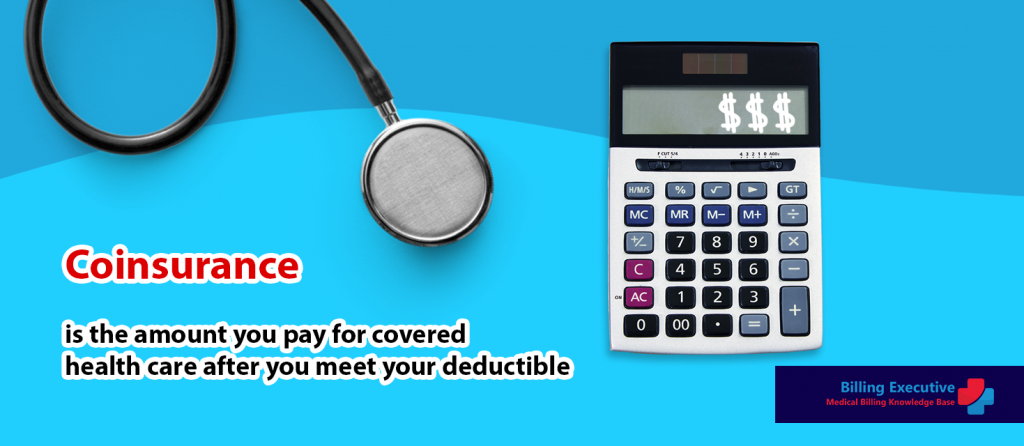Coinsurance is the amount, generally expressed as a fixed percentage, an insured must pay against a claim after the deductible is satisfied. In health insurance, a coinsurance provision is similar to a copayment provision, except copays require the insured to pay a set dollar amount at the time of the service. Some property insurance policies contain coinsurance provisions.

What exactly does ″Coinsurance″ mean?
Coinsurance refers to the percentage of treatment costs that you have to bear after paying the deductibles. This amount is generally offered as a fixed percentage. It is similar to the copayment provision under health insurance.
For example, if your coinsurance is 20%, then you will be liable to bear 20% of the treatment cost while the rest 80% will be borne by your insurance provider.
How it works – if your expenses towards treating a certain disease are Rs. 10,000, you will be required to pay Rs. 2000 while Rs. 8000 will be covered by your insurance policy. This amount is generally calculated after you have paid your deductibles.
Following are a few features of coinsurance plans:
- It helps to protect insurers against large claims.
- Policyholders are required to pay their deductible amount before their coinsurance plan comes into play.
- The percentage of coinsurance remains fixed.
- This percentage adheres to the out-of-pocket maximum that you can pay for a year before your insurance policy pays the rest of it.
How Do Homeowners Insurance coinsurance Work?
One of the most common coinsurance breakdowns is the 80/20 split. Under the terms of an 80/20 coinsurance plan, the insured is responsible for 20% of medical costs, while the insurer pays the remaining 80%.1 However, these terms only apply after the insured has reached the terms’ out-of-pocket deductible amount. Also, most health insurance policies include an out-of-pocket maximum that limits the total amount the insured pays for care in a given period.
Homeowners are responsible to pay their deductible before the insurance company pays a claim. Some homeowners insurance policies state the deductible as a dollar amount or as a percentage, normally around 2%. Dollar amounts are based on individual claims. So if you file a claim for $10,000 now and a $25,000 claim six months later and have a $1,000 deductible, you are responsible for $2,000 out of pocket ($1,000 for each claim) while your insurer covers the rest. With percentage claims, you agree to pay a portion of your property’s insured value for individual claims.
This is basically done by all insurance companies to limit the insurer’s from making small claims and in a way to tell them in advance that a part of the total sum will be paid by them.
This way, only genuine claims are made. It is very important to understand the deductible structure of a health insurance plan before planning to buy any particular policy.
Please Note:
- Copay plans may make it easier for insurance holders to budget their out-of-pocket costs because it is a fixed amount.
- Coinsurance usually splits the costs with the policyholder 80/20%.
- With coinsurance, the insured must pay the deductible before the company covers its 80% of the bill
Coinsurance also applies to the level of property insurance that an owner must buy on a structure for the coverage of claims.
Conclusion:
Coinsurance is the amount an insured must pay against a health insurance claim after their deductible is satisfied. Coinsurance also applies to the level of property insurance that an owner must buy on a structure for the coverage of claims. Coinsurance differs from a copay in that a copay is generally a set dollar amount an insured must pay at the time of each service. Both copay and coinsurance provisions are ways for insurance companies to spread risk among the people it insures. However, both have advantages and disadvantages for consumers.
About us
Billing Executive – a Medical Billing and Coding Knowledge Base for Physicians, Office staff, Medical Billers and Coders, including resources pertaining to HCPCS Codes, CPT Codes, ICD-10 billing codes, Modifiers, POS Codes, Revenue Codes, Billing Errors, Denials and Rejections.
We have more than 10 years experience in US Medical Billing and hand-on experience in Web Management, SEO, Content Marketing & Business Development with Research as a special forte.
Read More:
Denial Code PR 1– Deductible Amount
Common Medical Coding Errors And Their Consequences
Insurance Denial CO 38: Services Not Authorized by Providers
CO 40 Denial Code: Why Insurance deny Emergency Room claims?
